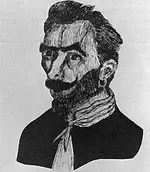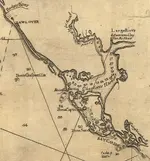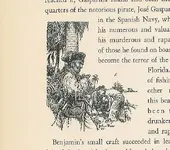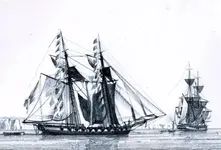Friends:
My original post was erroneous when I wrote that Francis Bradlee's excellent (and high recommended!) classic work did not mention our Jose.
I checked and, indeed, it does. This is one problem for someone of my age writing things from memory - sometimes memory serves, and sometimes it double-faults. In my own defense, I will point out that while this account may have a certain antique charm (the only reasonable explanation for Mr. Bradlee's otherwise meticulously documented work) it is far from reliable. When the write frequently uses a turn of phrase such as "the story goes" it's clear it's a sea yarn and not fact.
Piracy in the West Indies and Its Suppression
By Francis B. C. Bradlee
THE ESSEX INSTITUTE (SALEM, MASSACHUSETTS: 1925)
Through the kindness of Robert S. Bradley, Esq., of Boston, president of the Charlotte Harbor and Northern Railway Company of Florida, a most interesting, and, it is believed, accurate account of the famous, or rather infamous, Gasparilla, is here reproduced. It was originally printed in pamphlet form, to be distributed among the patrons of the railway and the Boca Grande Hotel, but the story proved so thrilling that the little brochure went out of print rapidly and is now quite rare.
"This narrative was compiled by the writer from incidents told by John Gomez, better known as Panther Key John, a brother-in-law of Gasparilla and a member of his crew, who died at the age of one hundred and twenty years, at Panther Key, Florida, twelve miles below Marco, in the year 1900; also from records left by John Gomez, Jr., the cabin-boy on Gasparilla's ship, who was kidnapped by Gasparilla, and who witnessed the death of this pirate and all on board his vessel. He died and was buried at Palmetto, Florida, in 1875, at the age of seventy years.

[from the brochure]
"While it is almost impossible to obtain exact information concerning this outlaw, owing to the numerous and conflicting accounts, the writer has tried to put into readable form a few of these stories concerning Gasparilla, and has only used such accounts where two or more sources agreed. However, it is well to keep in mind that owing to the long lapse of time between the death of Gasparilla and the present year nearly all old landmarks have gone."
"The Story of Gasparilla."
"The romantic age of the Gulf is past, the days when pirate bands preyed upon the peaceful merchantman, stole his goods, and carried away his women passengers, have gone, but romance still holds sway in the minds of each of us, and in the pirate Gasparilla we find a story that is full of the spice of romantic adventure, that abounds with thrills, and causes the pulse to beat just a little faster at some daring exploit, the eyes to fill with water at some touching story, or the fists to clench in the good American way at the brutal butcheries that authentic documents show were committed. Gasparilla has gone, his pirate gold lies hidden somewhere on the isles of Charlotte harbor, but the bleached bones of his murdered victims, with the stories that have drifted down from past generations, give to the world a synopsis of the life and death of Gasparilla, the terror of the Southern Seas.
"His name was Jose Gaspar (Gasparilla meaning Gaspar, the outlaw). He stood high in the graces of the Spanish Court, so high indeed that he filched the crown jewels. Jose was also an officer of high standing in the naval affairs of the Spaniards. Some records give him the honor of being what we would call an admiral. His theft discovered, he deserted his wife and children, gathered together a nice lot of cut-throats, stole the prize vessel of the Spanish fleet, and escaped. This happened in the year 1782. A price was declared upon his head, and, it is stated, when Gasparilla heard this decree, he swore eternal vengeance upon all Spaniards in general, and commenced to destroy the commerce of Spain.
"The Gulf of Mexico at that time being a rendezvous for pirate fleets, Gaspar settled in Charlotte Harbor and built upon the shores of what is now called Turtle Bay twelve houses, where, under guard, his female captives were placed, all male prisoners being killed when captured. The buildings were constructed of palmetto logs, and arranged in a semi-circle close to the water's edge.

[17871]
"About one hundred yards further inland the burying ground was discovered several years ago, containing not only the bones of his men, but the skeletons of his murdered women captives. Many a touching story has been unearthed when the ghostly remains were uncovered - stories of great strong men who died in the fight, of women who died to save their honor, and of nobility we even find a trace, but these are only traditions, and the story of 'The Little Spanish Princess,' as told by old Panther Key John Gomez, we will relate later on.
“Close to Turtle Bay lies the little Isle of Cayopelean. Upon this island stood a burial mound fifty feet high and four hundred feet in circumference at the base, built centuries earlier, it is thought, by the Mound Builders of a prehistoric race. Excavations in this mound have produced ornaments of gold and silver, together with hundreds of human skeletons. On its summit Gasparilla constructed an observation tower, where always a grim sentinel was stationed and looked across the warm, smiling waters of the Gulf for a victim.
"The present Isle of Gasparilla the pirate named for himself. Taking the best of everything when a capture was made, he chose the best of the islands in Charlotte Harbor for his own secret haunts. It is said that Jose was saluted the King of the Pirates, and his home on Gasparilla Island was regal in its fittings.
"Some writers have said that Gasparilla joined Pierre LaFitte, the famous French pirate, while others have stated on good authority that LaFitte joined Gasparilla's band, contributing a boat and thirty men.
"While taking the census of 1900 two gentlemen stopped at Panther Key and spent the night with John Gomez. The race of the old buccaneer was nearly run, but all through that night he told a story of piracy that could scarce be believed, yet it was a dying man that was clearing his soul before his Maker. He told of the looting of ships, the massacre of innocents, and last of all, when his life had nearly passed, he told the story of 'The Little Spanish Princess,' whose name he did not remember. He told where the body would be found, and a sketch was prepared under his direction, and in recent years in the exact location as described the skeleton of a beheaded woman was found. This is the story.
"In the early days of the year 1801 a princess of Spain sailed in great state for Mexico. While in that country she was royally entertained by its Ruler, and to show her appreciation to the Mexican people she prevailed upon the nobles to allow her to take eleven of Mexico's fairest daughters away with her to be educated in Spanish customs. A treasure of much gold, bound in chests of copper, it is said, was in cargo. When about forty miles from what is now Boca Grande, Gasparilla engaged them in combat, killed the crew, took the gold, and carried away as captives the princess and the eleven Mexican girls. The princess he kept for himself, the maids were divided among his men. The little Spanish princess spurned the one-time favorite of the King, and Gasparilla swore that if she did not return of her own free will the affections lavished upon her, she would be beheaded, and the story goes the threat of Gaspar was fulfilled. Far away from her native land, alone on a tropical isle, the little princess still lies in the lonely bed made for her by Gasparilla. The night birds sing in the dusk and lull her spirit to rest in the evening, and the moon throws kindly shadows o'er the spot where royalty sleeps.
"From members of Gaspar's crew many a strange story has drifted down concerning him, his traits, his ways, his passions. He was polished in his manners and a great lover of fashionable clothes; fearless in fight, and at all times cruel in his nature. Concerning women he was fanatical, and his houses were always filled with captives. It is stated beauty was essential with him. He kept for himself a certain number of picked beauties, but so fickle was his nature that when an additional capture was made and a new face appealed to him, one of his old loves must forfeit her life to make room for the new favorite. That this was true there is no doubt, as the graveyard of Gasparilla tells its own terrible story.
"In 1819 the United States, having obtained, under the Louisiana Purchase in 1803,* [*Florida belonged to Spain, therefore was not included in the Louisiana Purchase from France in 1803. It was acquired by the United States by special treaty in 1819.] the states bordering on the Gulf, made war upon the robber bands. On Sanibel Island a conference was held by all the pirates, and with the exception of Gasparilla, Baker, Caesar, and old King John, all sailed away, to be heard of no more.
"Nearly two years later, the war on piracy becoming too severe, Jose and his crew agreed to divide their wealth, which was then estimated at thirty million dollars, to give up piracy, and live as honest men the rest of their lives. This was decided upon and plans made accordingly.
"In the spring of 1822, while getting together his treasure for division, which at that time was hidden in six separate hiding places, he cited what appeared to be a large English merchantman just off Boca Grande Pass. It is said his greedy eyes lit with pleasure at the thoughts of just one more victim ere his piratical days were over. Closely following the shore-line of the Gulf, he slipped into Charlotte Harbor through what is now known as Little Gasparilla Pass, crept around Gasparilla Island, and gathered together his crew. Great excitement reigned when the plans were unfolded. The band of eighty men was divided into two parts, he commanding thirty-five men, LaFitte thirty-five, while ten were left in charge of the camp. At about four in the afternoon Gasparilla and his men dashed through the Boca Grande Pass for the English prize; fast overtaking the fleeing ship, the black flag was hoisted, and his men stood ready with the grappling hooks, but suddenly the English flag floated down and the Stars and Stripes pulled in place; in a moment guns were uncovered on deck, and Gasparilla, realizing that he was in a trap, turned to flee. His boat, disabled by the shots from the war vessel and capture staring him in the face, he wrapped a piece of anchor chain around his waist and jumped into the sea. His age at his death was about sixty-five. His crew was hanged at the yardarms, with the exception of the cabin-boy and the ten men left in charge of the captives, they having escaped to the mainland. Panther Key John was in this gang. The cabin-boy was carried to New Orleans, where he remained in prison ten years.
"LaFitte, watching the battle from afar, turned and fled, but the next morning his boat was captured and sunk off the mouth of the Manatee River. Whether he was captured at this point is not known, as so many conflicting stories arose concerning him, still it is a positive fact that he was buried at New Orleans.
"For thirty years the craft of Gasparilla was visible from Gasparilla Island, lying five miles off Boca Grande Pass, but the sand has now completely covered the wreck.
"The treasure of Gasparilla still lies unmoved. The bones of the bold buccaneer, with his pirate ship, have vanished, but legends from the fisher-folk say that sometimes in the dead of night, off Gasparilla Island, when the waves are singing a lullaby to the weary and the wind is whispering soft messages through the palmettos, the phantom fleets of the pirate crew arise from their ocean resting places and pursue, as in days of old, the ghost ships of the merchantmen."
Good luck to all,
~The Old Bookaroo








